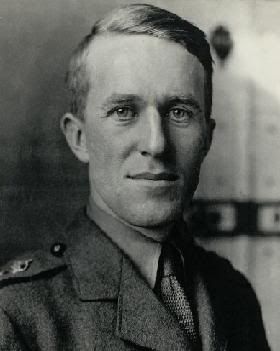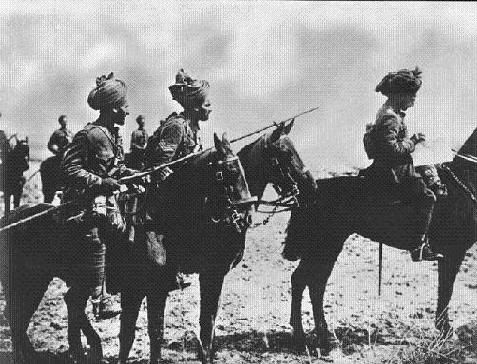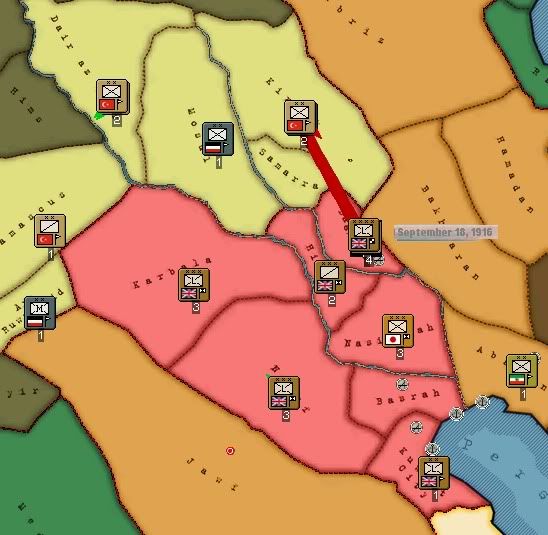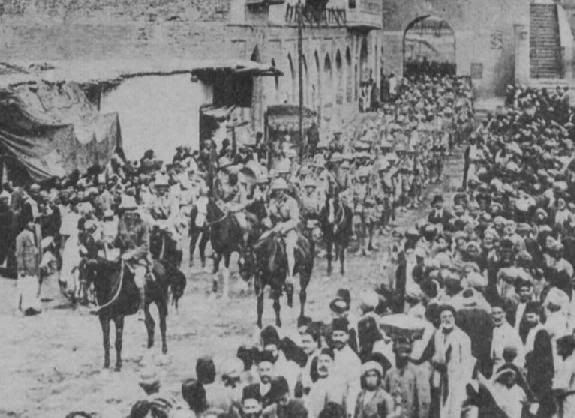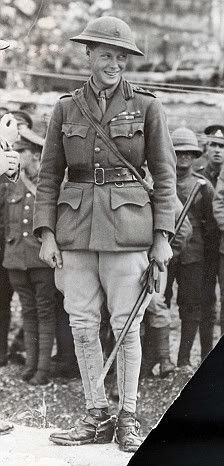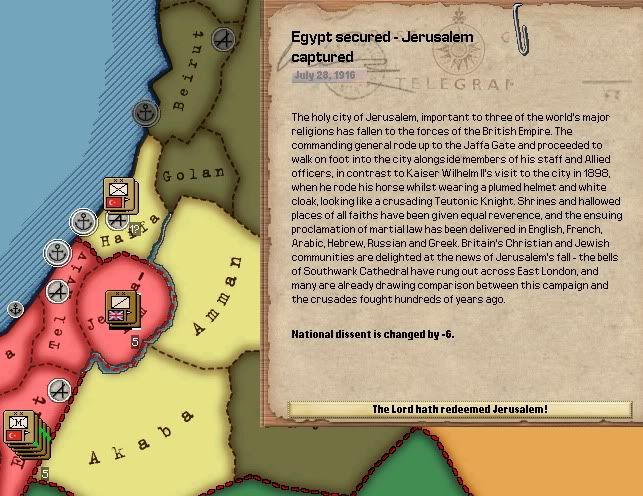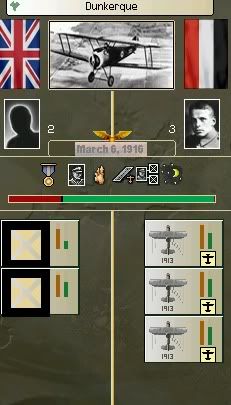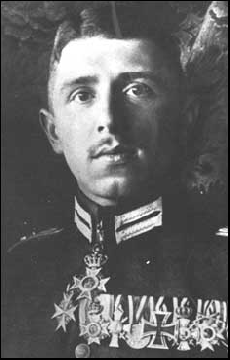Chapter forty-five: Jerusalem, Jerusalem!
Meanwhile, Allenby began to prepare the advance of the EEF to Jerusalem. He began by moving the headquarters of the EEF from the Savoy Hotel in Cairo to a tent near Rafa, near the frontline, showing his desire to fight. Allenby also visited the front line to familiarise himself with the troops under his command, something that Murray never did. The reinforcement of the EEF was not limited to a new commander: two new divisions were in Palestine by the end of June: the 74th (Yeomanry) and the 52nd (Lowland) Division. Additionally, Allenby removed some commanders for which he had no use (among them, the Chief of the EEF’s General Staff, Major-General Sir Arthur Lynden-Bell -or ‘Belinda’ (1) as he was known by other officers-, who was replaced by Major-General Louis Jean Bols, who had served with Allenby in France). Allenby found himself with a "poisoned chalice" when Lieutenant Alexander Hardinge became his Aide de Camp. Hardinge was the second son of the Viceroy of India and his elder brother, Edward, had been killed with the 15th King's Hussars in December 1914. Allenby hated this situation, as he felt performing some kind of odd rendering of the fateful Buller-Roberts affair (2). Anyway, he was grateful that His Royal Highness, Edward, Prince of Wales, who those days was travelling through Africa and was by then in Khartoum, remained, thus, very far away from the warfront, to the changrin of the young prince and heir of the Empire.
The Prince of Wales in Sudan.
Allenby had its own problems. While Asquith and the War Committee encouraged him to advance as far as possible, General Robertson told Allenby that the EEF was to fight with a limited amount of resources. In any case, he set set the capture of the Jerusalem-Jaffa line as his main objective and began to consider the available options with General Chetwode, who impressed Allenby with his attention to detail. Then the War Cabinet sent a message to Allenby asking him to attack as soon as possible. He had prepared for the possibility of fighting the Turks at once instead of fostering his forces for a 1917 offensive, therefore, the War Cabinet’s instructions were not a problem.
Both the EEF’s Intelligence Department and the War Office in London overestimated the enemy’s strength, suggesting that the Turkish Army in Palestine was composed of eleven full strength divisions, when in actuality, the Turks had just six depleted divisions at its disposal, a situation worsened by the Arab Revolt. Then Allenby attacked on July 20th. With a calvary feint towards Ascalon, the British attacked Sheria, in the centre of the Gaza–Beersheba line while the RFC bombed the Turkish airfields. As the day progressed, the Ottoman units began to loose ground and then, all of the sudden, the Turkish front collapsed and several disorganised and demoralised Ottoman columns flew to the back, being harassed as they retreated by British planes dropping bombs and firing machine-guns. Despite these difficulties the Ottoman Army successfully carried out an difficult retreat to establish a new defensive position west to east from the mouth of the Nahr Sukereir on the Mediterranean Sea to Beit Jibrin not far from Tel el Khuweilfe in the Judean Hills, but most of its trenches were still unfinished when Allenby attacked again on July 23rd.
Going over the top in Palestine.
Despite the efforts of von Falkenhayn, the commander of the 7th and 8th Turkish Armies, and several well-spirited but uncoordinated counterattacks, the Allied forces crushed the last remnants of Ottoman resistance and the cavalry raced then towards Jerusalem. On July 24th the commander of Desert Mounted Corps, Lieutenant General Sir Henry George Chauvel, issued orders for the Yeomanry and the Anzac Mounted Divisions to continue the advance on Ramleh and Latron. The Yeomanries reached the Jerusalem road at Abu Shusheh, finding no trace of the Ottoman defenders. The next day, the New Zealand Mounted Rifles Brigade secured the left flank of the EEF by occupying Jaffa, on the Mediterranean coast. Even if the EEF was now operating at the extreme limits of their lines of communication, its advance did not paused, thanks to the effort of the motor lorries of the British Army Service Corps (ASC) Motor Transport companies and camels of the Egyptian Camel Transport Corps. By July 25th the 4th Light Horse Regiment reached the Judean Hills. From there a simple message was sent to Allenby:
"
Johnny Turk nowhere to be seen. Jerusalem ripe to be taken".
Allenby's plan was to avoid fighting in or near Jerusalem, and the lack of Turkish resistance just suited him, so he ordered his forces to begin the final advance to Jerusalem. Bethlehem felt on night of July 27th and, on the following morning, the mayor of Jerusalem, Hussein Salim al-Husseini, delivered the Ottoman Governor's letter surrendering the city to the baffled Private S. Baldrick , of 2/19th Battalion, Tydfilshire Light Infantry Regiment , who was just scouting ahead of Allenby's main force, searching for food. By sheer miracle, the letter arrived to Brigadier General C.F. Watson, commanding the 180th Infantry Brigade (3). On Juy 30th, ten days after the beginning of the British offensive, General Edmund Allenby made his formal entry into Jerusalem on foot through the Jaffa gate.
During the fighting advance to Jerusalem, the total British Empire casualties were 9,000, with the Ottoman suffering 17,000 casualties; some 3,000 prisoners were captured, 50 guns, and scores of machine guns and rifles were also captured.
Then the war moved to a new battlefield, in a new kind of warfare that would have an unexpected result for the British Royals. As the Great War unfolded, aircraft, which had previously been dismissed as having little military value, began to prove their critics wrong. As a result of this increased importance, the Royal Flying Corps, the air arm of the British arm from 1912 until 1918, fielded 185 aircraft in the area of the Somme offensive, supported by more than 200 French machines. As a result of the initial experiences, the armed forces on both sides began to put considerable thought into concepts for highly specialized types of combat aircraft. Not all of these concepts survived the test of combat. One such concept was that of a "battle-plane:" a large, heavily-armed, multi-engined aircraft designed to be a fighter aircraft which, eventually, proved to be too vulnerable when facing more maneuverable single seat fighters. However, they did prove highly successful when they were fitted with bomb racks and pressed into service as medium bombers. In Germany, these "battle-planes" (
Kampfflugzeug) were re-assigned to the bomber role. This kind of biplanes had been in production since 1915 (for instance, the first prototype of the Gotha G.I flew on 30 January 1915 and was used as a reconnaissance plane in the Eastern Front although only small numbers -five or six-).
Boelcke managing to show a new spectrum of
reality to the RFC even without flying a fighter...
From 1916 onwards, aircrafts also undertook direct support of infantry operations, attacking trenches and maintaining contact between advanced ground units and command headquarters and, of course. The first dogfigths took place in March 1916, when the "Fokker Scourge" roamed the skies: Developed by the Dutch Anthony Fokker, the German E-type became the first genuine fighter of the world. In use since mid 1915 (E-1), it soon achieved air superiority, not because it was an exceptional aicraft, but because of the new air-to-air combate techniques developed by the German pilots. By the spring of 1916 the new Allied fighters (the British Airco DH-2 and the French Nieuport 11) began to regain the control of the skies from the hands of the Germans.
Allied air superiority was maintained during the battle of the Somme, and teh improved effectiveness of the Allied Air Forces proved disturbing to the German High Command. As a result of this, the German Luftstreitkräfte was reorganized into strategic bombing squadrons, the specialist close support squadrons and the specialist fighter squadrons (
Jagdstaffeln). Equipped with the new Albatros fighters, the Jagdstaffeln (or Jastas) were to give a hard beating to the RFC and the French
Aéronautique Militaire towards the end of 1916.
Max Immelmann (1890 – 1916), one of the first German Aces
and a legend of the Fokker Scourge.
It was then when the German High Command decided to test the resolve of the British population with a strategic bombing campaign. The first bombing attacks took place during the first days of the war (a Zeppelin bombed Liège on August 6th, 1914 and Paris was regularly bombed by a German pilot flying aerial reconnaissance missions over Paris in his Taube during the Battle of the Marne). The attacks against England by the German Zeppelins were approved on 7 January 1915 by Kaiser Wilhelm II, who forbade attacks on London, fearing that his relatives in the British royal family might be injured (These restrictions were lifted in May, after British attacks on German cities.) The first attacks on England came on 9 January around Yarmouth and King's Lynn. The Zeppelin proved too costly compared to airplanes, too large and slow a target, too cumbersome, its hydrogen gas too flammable, and too susceptible to bad weather, anti-aircraft fire (six were destroyed over England during 1916) and its use began to be reduced that year. As the Battle of the Somme raged, the German began to use their first heavy bombers, the Gotha G.II, which started its raids in August 1916, and the Zeppelin-Staaken R.IV, which joined the attacks in January 1917 (4). It was a daylight bombing offensive against England called Operation
Türkenkreuz.
As the planes had several shortcomings, its first operations had no much effect initially and England did not bother too much about them. However, the Kaiser and the German High Command was enthusiastic about this chance to strike at England, in combination with the unrestrcited submarine warfare, and presssed for more action. This enthisuasim would lead to further attacks and more powerful bombers, as the Friedrichshafen G.III and the Gotha G.III. Soon England would face a kind of war.
A Gotha GII, bane of the RFC and particular headache to George V
(1) I swear it: this 'belinda' motto is absolutely true, it's not one of my silly jokes, although it may very well look like one of them.
(2) During the Boer War, Lieutenant Frederick Roberts, V.C., son of Field Marshall Roberts, VC, served under General Redvers Buller orders and was killed at Colenso, leaving poor old Buller the task of informing Lord Roberts of the demise of his heir.
(3) Due to his excellent postmanship, Private Baldrick was kicked (literally) back to England by a grateful Allenby.
(4) I've rushed its first actions around six months or so... In OTL it was used on the Eastern Front from June to September 1917 and on the Western Front from September 1917 till the end of the war.
@Enewald: With Greek neutral and silent and my reluctance to commit something as silly as the Salonica beachhead... a long long way to Athens, methinks.
@trekaddict: And the whole Japanese air force in France doing interdicting missions...
@quaazi:

@c0d5579: In this alternate universe... who knows.
About killing Attlee... blame the coin...

Yes, that's a pretty nice advance, but, as we have seen in this chapter, after this awesome advance the EEF -and the MEF- are going to spend some months building roads...
And the Ottoman army only fired from time to time... I'm also wonder about how the heck they managed to withdraw so fast. As if they were Italians!

(Surprised, uh? I didn't mentioned the French...)
@trekaddict (2): I must confess that I take too much care about some historial characters while I drop some other people too easily... My easygoing way of being...
@Nathan Madien: I'm sure that the Laborist party will, in due time, manage to find a replacement.
@Draco Rexus: See what you (and many others) have done...
@Nathan Madien (2): Don't worry. Tomorrow you'll find a worthy replacement .
@Milites: No, it the British Empire saving the world in Mesopotamia with some Japanese help.
About Attlee... I killed Tatcher before she was even born, for Sake's sake!


